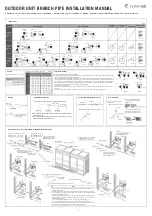
Page 10
# 48478A006
The ball valve is equipped with a service port with a
factory-installed Schrader valve. A service port cap
protects the Schrader valve from contamination and
serves as the primary seal.
Leak Testing
After the line set has been connected to the indoor and
outdoor units, the line set connections and indoor unit
must be checked for leaks.
Figure 10
Service Valve
Valve Closed
Valve Open
Schrader
Valve
Schrader valve open
to line set when valve is
closed (front seated)
Service Port
Service
Port Cap
Insert hex
wrench here
(valve front seated)
To outdoor coil
To indoor coil
To indoor coil
Stem Cap
Service Port
To outdoor coil
Service Port Cap
Stem Cap
Insert hex
wrench here
To Open Liquid or Suction Line Service Valve:
1. Remove stem cap with an adjustable wrench.
2. Use a service wrench with a hex-head extension to back
the stem out counterclockwise as far as it will go. Use a
3/16" hex head extension for liquid line service valves
and a 5/16" extension for suction line service valves.
3. Replace the stem cap. Tighten finger tight, then
tighten an additional 1/6 turn.
To Close Liquid or Suction Line Service Valve:
1. Remove the stem cap with an adjustable wrench.
2. Use a service wrench with a hex-head extension to turn
the stem clockwise to seat the valve. Tighten firmly.
3. Replace the stem cap. Tighten finger tight, then
tighten an additional 1/6 turn.
Suction Line (Ball Type) Service Valve
Suction line (ball type) service valves function the same
way as the other valves; the difference is in the construc-
tion (see Figure 11).
Ball Type Service Valve
(Valve Open)
Figure 11
Use adjustable wrench. To open, rotate stem
counterclockwise 1/4 turn (90°). To close, rotate
stem clockwise 1/4 turn (90°).
Using an Electronic Leak Detector
1. Connect the high pressure hose of the manifold
gauge set to the suction valve service port. (Normally
the high pressure hose is connected to the liquid line
port; however, connecting it to the suction ports helps
Fire, Explosion, and Personal Safety Hazard.
Failure to follow this warning could result in
damage, personal injury, or death.
Never use oxygen to pressurize or purge
refrigeration lines. Oxygen, when exposed to
a spark or open flame, can cause damage by
fire and/or an explosion, that could result in
personal injury or death.
WARNING











































